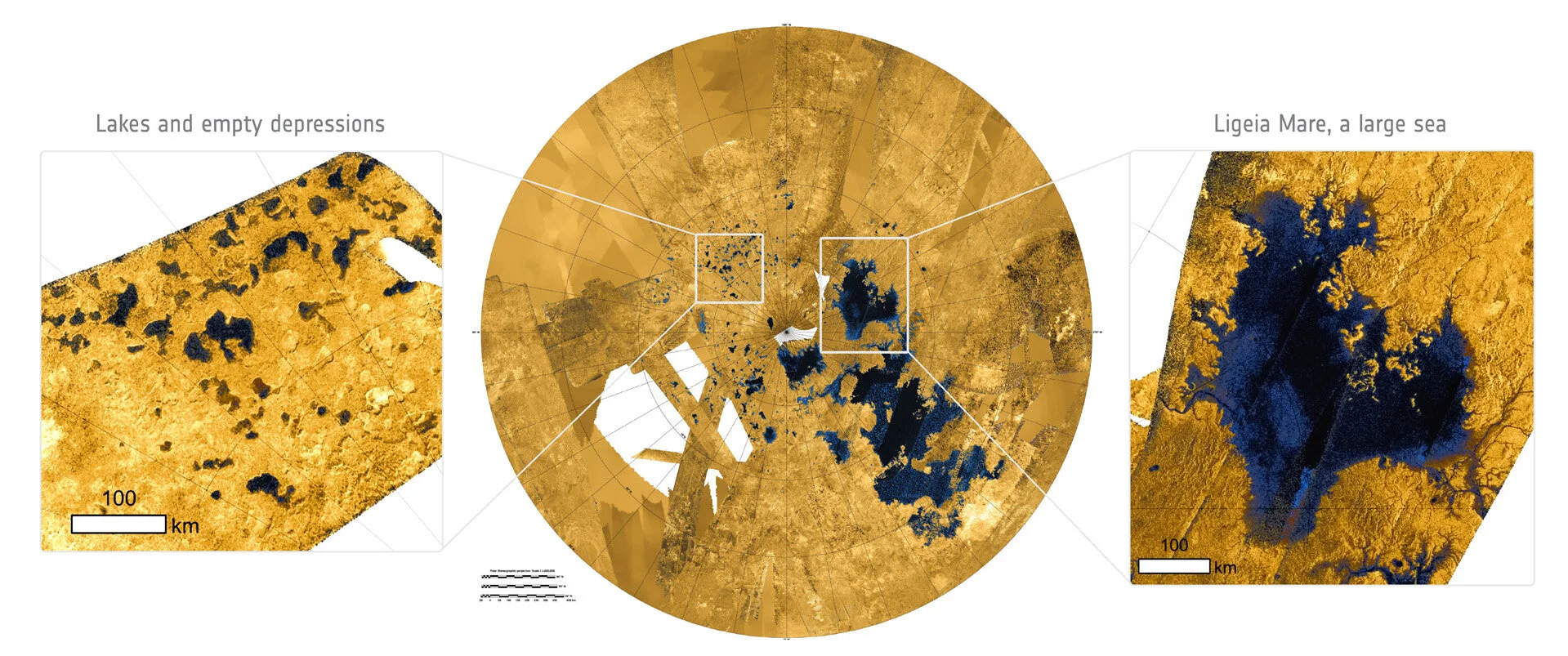In 2014, the Cassini-Huygens mission discovered bright spots moving with time in the seas and lakes of Saturn’s moon Titan. For a long time scientists could not understand what kind of strange phenomenon this was. It looks like an explanation has now been found: about large icebergs (albeit not made of water ice).
Titan is the second largest moon of the Solar System, with a diameter of approximately 5,150 kilometers and a surface area larger than Eurasia and Africa combined. It orbits Saturn, meaning it is so far from the Sun that it receives a hundred times less solar energy per unit area than Earth. Therefore, the temperature of its surface is almost -180 degrees. Accordingly, its surface consists of ice, and its analogue of local dunes even contains mothballs. The satellite has many rivers, lakes and seas. However, they are not filled with water, but liquid ethane, propane and methane. The total volume of hydrocarbons in these seas is several times greater than all known reserves of this type on Earth.
Titan is extremely difficult to study because its mostly nitrogen-containing atmosphere is four times denser than Earth’s (the pressure at the surface is one and a half times higher than Earth’s). In such a dense and cold atmosphere, dense fog and clouds constantly prevail. It is very difficult to observe them in visible and some other ranges. In 2005, the Huygens lander made the first (and so far last) soft landing outside Mars orbit, greatly increasing our knowledge of Titan, but much remains unclear. Since 2014, the Cassini spacecraft has been detecting some bright spots in Titan’s seas with the help of radar, and these spots then change their positions. This caused quite a bit of consternation. This is where the idea of floating ice emerged, but what kind of ice was it?
The fact is that the main component of the seas of the satellite of Saturn is liquid ethane with an admixture of liquid methane, with a density of about 0.6 tons per cubic meter. So it is a very light liquid. However, solid ice, which is mostly ethane, does not float very well under these conditions; It must be heavier than the liquid surrounding it. Additionally, liquid ethane and methane have a much lower surface tension than water, making it more difficult for dense objects to float in water. Finally, pure ethane only forms at temperatures below -182 degrees.
But Titan’s atmosphere is so dense that even at the poles seasonal temperature fluctuations are extremely small. Therefore it is unlikely that stable solid ethane will be present there. Previously, they tried to justify the possibility of floating hydrocarbon ice sheets in Titan conditions due to high porosity: if it exceeds five percent, such ice will be able to float. However, it remained unclear what such porous ice might consist of.
Authors of the new study published Geophysical Research Letters, approached the problem from the other side. They note that molecules much heavier than nitrogen and methane (the two main gases of the local gas shell) must inevitably form in Titan’s atmosphere. Therefore, they must fall to the surface like terrestrial snow. Only local snow will consist largely of nitriles (compounds of carbon, hydrogen and nitrogen), triple-bonded hydrocarbons and benzenes.
With the help of calculations, researchers discovered that such snow, composed of hydrogen cyanide, can eventually form ice with high porosity of up to 25-60 percent by volume. In this case, if we are talking about a sea rich in ethane, these ices will be able to float in the sea. The study’s authors note that ice in an alternative composition would pose significant problems in long-term navigation in Titan’s seas.
They also note that such porous ice is unlikely to form directly from hydrocarbon “snowflakes” falling into seas and lakes. They need to be small enough to not swim long enough and not drown. It is more likely that such “snow” fell on the shores of Titan’s seas and managed to form larger lumps there, and then the waves washed away the formed loose ice and ripped off large areas from it, as with icebergs in the Earth’s seas. .
Scientists say a similar scenario could explain another unusual feature of the seas and lakes on Saturn’s moon: the absence of large waves on them. In the region saturated with floating ice, the formation and stable existence of large waves is seriously hindered.
It is worth noting that such studies are far from theoretical. Titan is one of the most interesting places to study in the Solar System. And it’s not just about exotic hydrocarbon seas, but also what lies beneath them. Large oceans of subsurface water exist deep within the moon. It would be wise in the future to examine these in terms of their relationship to life. However, the tasks required for this require heavy equipment. In 2005, Huygens landed on what appeared to be a solid surface during mission planning, but in practice it turned out to be close to swamp. A better understanding of the composition of Titan’s surface is essential to the success of future landings there.













